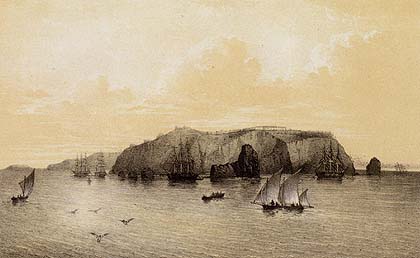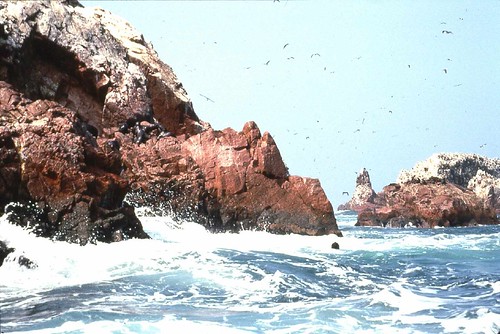7.14.2005
Guano wars

The Chincha Islands in 1864.

The nearby (and also guano laden) Islas Ballestas, off the coast of Perú. Photo by Don Ball.
Found this beaut in the South American Explorers Club e-newsletter today:
Toes!Fellow Peruvianists, please help me out. One thing I can't determine is whether the Chincha Islands are the same as the Ballestas. Were the Chinchas renamed at some point? Regardless, I would imagine that they are much the same -- chock full o' shitty birds.
That’s what a horrified Robert Murphy saw sticking up from the ground when he visited the Chincha islands at the height of the guano boom. These were the toes of the dead, their bodies thrown into shallow graves, all victims of the lucrative trade.
Fortunes were made in guano. The era between the 1840s and the 1890s was marked by a frenzy similar to that of America’s gold rush; to Peruvians, the commodity was tantamount to gold, and for good reason. One ton of guano is the equivalent of 33 tons of farmyard manure. Guano is also high in nitrates, a key ingredient in the manufacture of explosives. Guano’s virtues have been known since ancient times. The Inca put to death anyone who killed guano-yielding birds.
In the Chincha islands, guano had built up over centuries. On some islands, guano deposits were 22 feet thick. Guano deposits were estimated at 11 million tons, and by the 1840s, a brisk trade had developed. Income from guano accounted for a whopping 80 percent of Peru’s revenue. So valuable was guano for agriculture and weapons production that more powerful countries maneuvered to cash in. Spain occupied the islands in 1866, ending the Peruvian windfall.
To mine the guano, unscrupulous speculators brought in Chinese laborers and worked many to death. A typical worker moved up to four tons of guano a day. So appalling were the conditions that 60 Chinese committed suicide between 1852 and 1854. [Ed: Click here for an interesting story about a ship of coolies who mutanied rather than be brought to the Chinchas.] But the ruthless exploitation continued and exports skyrocketed—nearly one million tons in the 1860s. A war-hungry Europe guaranteed ever-increasing exports.
In fact, guano of such strategic importance that it led to the War of the Pacific, also known as Nitrate Wars. This four-year conflict proved disastrous for Peru. In the end, Chile occupied all Peru’s guano islands and even imposed a war indemnity upon the defeated nation to be paid for by guano revenues. Such harsh policies ensured that Peru not only lost revenue from sales, but also security for needed loans.
Today, guano mining is controlled by the Peruvian government, and exploitation of this resource is carefully controlled and regulated.
For those of you heading to South America or even contemplating a trip, I highly recommend joining the South American Explorers Club. Their irregularly published magazine alone is a worth the price of membership. Inside, you'll find a bizarre blend of wit, academia and hippy backpacker lore. To get a taste of club membership, you can sign up for the club's free e-newsletter.
Comments:
<< Home
http://www.mundoazul.org/images/fotos/paracas_map2.jpg This is a link to a map of the bellestas islands and the Chincha islands. Not the same. Hope this clears it up for you! :)
Dawne
Post a Comment
Dawne
<< Home





